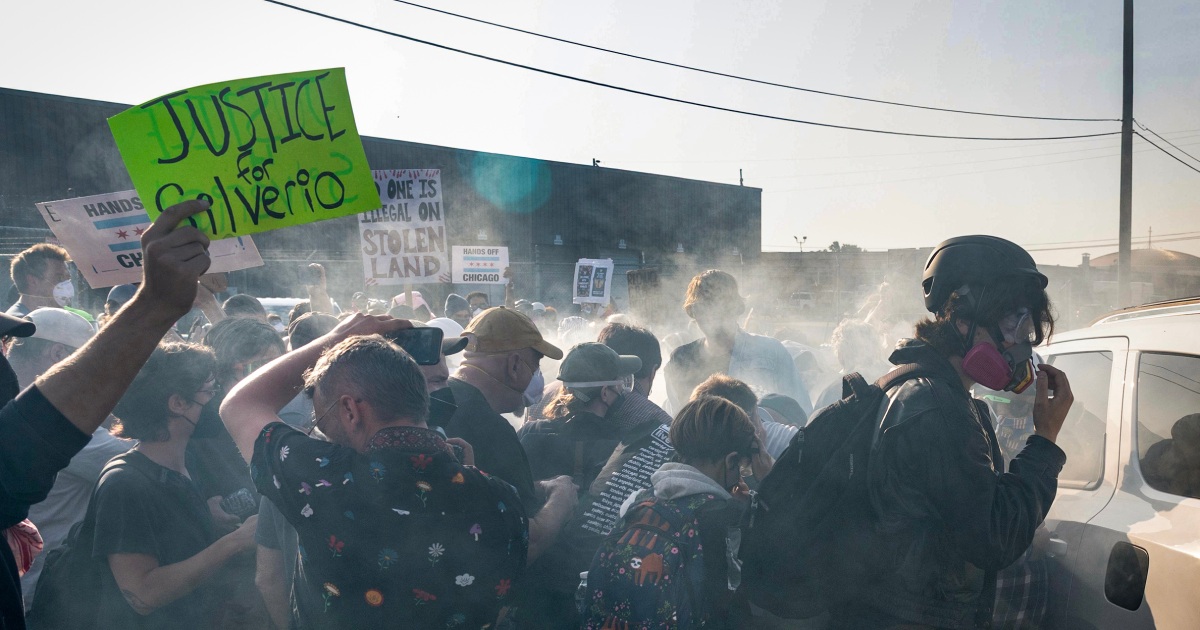Tear Gas Used in Clash at Chicago-Area ICE Site

Introduction
On Friday, federal officers in camouflage and riot gear clashed with protesters at a Chicago-area ICE site. The clash occurred as demonstrators blocked vehicles in protest of Trump's expanding enforcement sweep. Tear gas was used by officers as they clashed with the protesters, escalating the immigration crackdown.
Key Details
The use of tear gas on protesters at the ICE site is just one example of the increasing tension and violence surrounding immigration enforcement in the United States. The Trump administration's crackdown on immigration has led to numerous clashes between federal officers and protesters. In addition to tear gas, officers have also used pepper spray and physical force to disperse protesters and maintain control. The clash at the Chicago-area ICE site is just one of many instances where federal officers have resorted to aggressive tactics to quell demonstrations.
Impact
The use of tear gas on protesters raises concerns about the escalation of violence in immigration enforcement. Many are calling for a more peaceful resolution to the immigration debate and for the protection of protesters' rights to peaceful assembly. As the tension and violence surrounding immigration enforcement continues to escalate, it is important for all parties involved to find a peaceful and respectful way to address the issue. The clash at the Chicago-area ICE site highlights the urgent need for a more compassionate and humane approach to immigration policy in the United States.
About the Organizations Mentioned
ICE
**Immigration and Customs Enforcement (ICE)** is a federal law enforcement agency under the U.S. Department of Homeland Security (DHS), established in 2003 following the Homeland Security Act of 2002, which reorganized existing agencies post-9/11 to enhance national security[1][2]. ICE’s core mission is to protect the United States by enforcing immigration laws, conducting criminal investigations, and preserving public safety. ICE operates primarily through two major divisions: **Homeland Security Investigations (HSI)** and **Enforcement and Removal Operations (ERO)**. HSI focuses on investigating and disrupting transnational criminal organizations involved in customs violations, human trafficking, terrorism, and smuggling. ERO is responsible for the apprehension, detention, and deportation of individuals unlawfully present in the U.S., operating detention facilities and managing removal procedures[2]. ICE’s international reach is managed by the Office of International Affairs (OIA), a key overseas investigative arm coordinating with foreign governments to combat cross-border crime, such as arms smuggling, forced labor, and immigration fraud. OIA supports intelligence gathering, training, treaty implementation, and facilitates global cooperation to preempt threats before they reach U.S. borders[3]. With a workforce exceeding 20,000 employees across more than 400 offices worldwide and an annual budget of about $8 billion, ICE plays a pivotal role in U.S. homeland security[1]. Its activities, especially those involving immigration enforcement and detention, have made it a highly visible and sometimes controversial agency in public discourse, often referred to colloquially in Spanish as "la migra"[2]. Notable achievements include disrupting large-scale criminal networks internationally and supporting the enforcement of over 400 federal statutes concerning customs, immigration, and terrorism prevention. ICE’s dynamic operational scope—spanning law enforcement, international diplomacy, and legal administration—makes it a critical component of U.S. efforts to maintain national security and uphold the rule of law[1][2][







